 Every July 18, locals in Brussels take to the streets for the “Day of Beer,” a raucous parade in honor of their beloved national beverage and Arnold. No, not Schwarzenegger, Palmer, or Matsuo “Arnold” Takahashi, but rather Saint Arnold of Metz, a saint of the Roman Catholic Church and the patron saint of Brewers, as well as Arnold (Arnoul) of Soissons or Arnold or Arnulf of Oudenburg (ca 1040–1087), the patron saint of hop-pickers and Belgian brewers. We honor the Arnolds with five beers from Belgium in today’s in-house beer flight, Peaks and Pints Beer Flight: Arnold of Belgium.
Every July 18, locals in Brussels take to the streets for the “Day of Beer,” a raucous parade in honor of their beloved national beverage and Arnold. No, not Schwarzenegger, Palmer, or Matsuo “Arnold” Takahashi, but rather Saint Arnold of Metz, a saint of the Roman Catholic Church and the patron saint of Brewers, as well as Arnold (Arnoul) of Soissons or Arnold or Arnulf of Oudenburg (ca 1040–1087), the patron saint of hop-pickers and Belgian brewers. We honor the Arnolds with five beers from Belgium in today’s in-house beer flight, Peaks and Pints Beer Flight: Arnold of Belgium.
Arnold of Soissons received the nametag because he preached in the hop-growing region of Brabant, in what is now Belgium. Hops became more widespread when a Belgian princess married a Kentish prince and the dowry included land across from the Affligem brewery. Belgians reportedly sent the first hops to England for use in making beer. Anyhoo, Arnold of Soissons pulled his beer proliferation number after a monastery roof collapsed in Flanders, destroying the monks’ supply of beer. With only a few sad barrels remaining, Arnold asked God to lend a hand. The barrels multiplied, the monks and townsfolk rejoiced, and Arnold was popularly canonized on the spot. Arnold of Soissons, whose feast day is Aug. 14, is often confused with Saint Arnold of Metz and the same miracles, therefore, St. Arnold’s Fest Day, July 18, is associated with both Arnolds, depending on the source. To skip past the confusion, today’s in-house beer flight is called Peaks and Pints Beer Flight: Arnolds of Belgium.
Peaks and Pints Beer Flight: Arnolds of Belgium
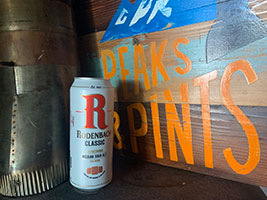 Rodenbach Classic
Rodenbach Classic
5.2% ABV, can
Brewed in West Flanders region of Belgium since 1821, Brouerij Rodenbach ages their beer in one of 294 oak casks (“foeders”) for a minimum of 2 years, before master brewer Rudi Ghequire crafts his Flemish red brown sour ales. Don’t let the fact that this is Rodenbach’s “entry-level” beer deter you—while it’s the most approachable and accessible of the bunch, it’s certainly not light on flavor or experience. A blend of 75% young ale and 25% two-year-old ale aged in oak foeders, it pours a hazy brown color, with mahogany-red glimmers. The flavor is an evenly balanced delicate blend of sweet malt, black cherries, orange, and a light acetic sourness.
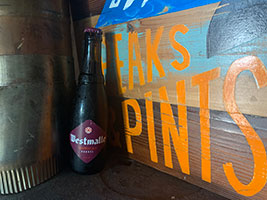 Brouwerij der Trappisten van Westmalle Dubbel
Brouwerij der Trappisten van Westmalle Dubbel
7% ABV, draft — with bottle in the cooler
In 1836 the Belgian Westmalle monastery became a Trappist Abbey and began brewing beer shortly thereafter. The holy suds they produced started out as an insider-only deal — a choice beverage to be made and enjoyed by Trappists and Trappists alone, but eventually they decided to expand and opened up a public beer hall in the early 1930s. Westmalle Dubbel is a dark, reddish-brown Trappist beer with a secondary fermentation in the bottle. The creamy head has the fragrance of special malt and leaves an attractive lace pattern in the glass. The flavor is rich and complex, herby and fruity with a fresh-bitter finish. It is a balanced quality beer with a soft feel in the mouth and a long, dry aftertaste.
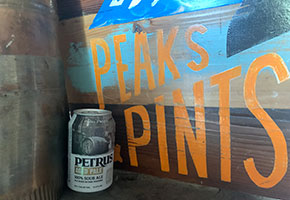 Brouwerij De Brabandere Petrus Aged Pale
Brouwerij De Brabandere Petrus Aged Pale
7.3% ABV
Petrus Aged Pale was never intended for the public. It was merely a blending beer, stored in 220 hectoliter oak foeders, used for Brouwerij De Brabandere’s Oud Bruin to give it a slightly sour flavor. It wasn’t until world-renowned beer expert Michael Jackson (no, not he who moonwalked) stopped by the brewery in the ’90s and wanted to try the beer. Jackson convinced De Brabandere to let him take the “mother beer” back home to the United States, which he named Aged Pale. Aged in one of the 15 25,000L oak vessels in the Petrus aging cellar, this beer is brewed and then aged in the aforementioned vessels for between 20 to 30 months. We get tons of oaky tannin and subtle malt kisses up front, which eventually turns into that red apple cider vinegar punch. Finish is lightly tangy and slightly sour with some dry lemon notes and a lingering puckering dryness.
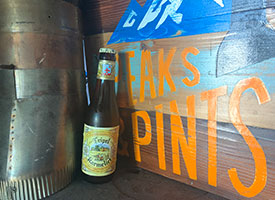 Bosteels Tripel Karmeliet
Bosteels Tripel Karmeliet
8.4% ABV
Belgium’s Brouwerij Bosteels utilizes a 340-year-old recipe for Tripel Karmeliet using wheat, barley and oats in the brewing. The result is a smooth and sweet Belgian golden ale that can appeal to both serious beer drinkers and folks looking for something cool to bring to a party. Tripel Karmeliet is still brewed to an authentic beer recipe from 1679 originating in the former Carmelite monastery in Dendermonde. The name Tripel Karmeliet refers both to its origin and its in-bottle refermentation. It benefits greatly from secondary fermentation, giving it some nice carbonation and a creamy head of foam upon pouring. The nose of the beer is redolent of spices and grass. Those spices also dominate on the palate, along with all that sweet oat and wheat malt. A restrained hop bitterness balances flavors of toffee and malt.
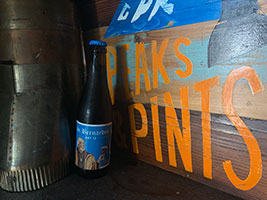 Brouwerij St. Bernard St. Bernardus Abt 12
Brouwerij St. Bernard St. Bernardus Abt 12
10.5% ABV
Brouwerij St Bernardus is famous for both their beers and their heritage. The brewery used to brew the famous Westvleteren beers before the monastery returned all production back to within the abbey’s walls. Their Abt 12 is a classic Belgian dark quadrupel brewed since 1946, on the basis of the original recipe compiled by the Westvleteren monks. The Abt, or Abbot, is the highest-ranking monk in the abbey; so perhaps it’s no surprise that the brewery sees the Abt 12 as the highest-ranking amongst abbey beers. It hits the nose with banana, tropical fruit, raisins, spices and rum. The flavors come through as intensely fruity, with notes of banana, pineapple, as well as spicy clove, añejo rum and anise. Throughout the sip, spicy pepper and black licorice counter the sweetness before a flash of bitterness segues to the beer’s enduring dry finish.
LINK: Peaks & Pints beer and wine cooler inventory
